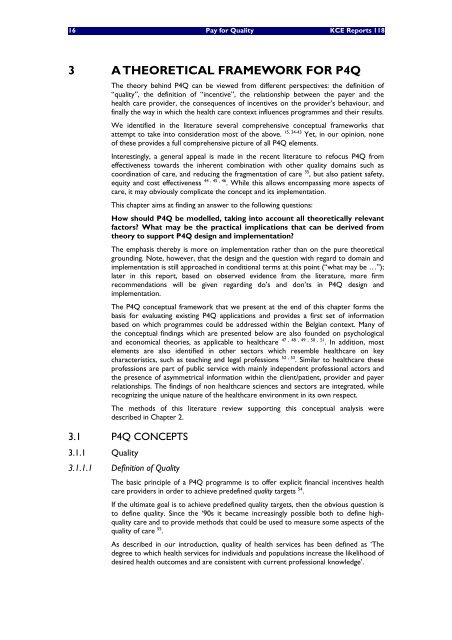Pay for Quality
Pay for Quality
Pay for Quality
You also want an ePaper? Increase the reach of your titles
YUMPU automatically turns print PDFs into web optimized ePapers that Google loves.
16 <strong>Pay</strong> <strong>for</strong> <strong>Quality</strong> KCE Reports 118<br />
3 A THEORETICAL FRAMEWORK FOR P4Q<br />
The theory behind P4Q can be viewed from different perspectives: the definition of<br />
“quality”, the definition of “incentive”, the relationship between the payer and the<br />
health care provider, the consequences of incentives on the provider’s behaviour, and<br />
finally the way in which the health care context influences programmes and their results.<br />
We identified in the literature several comprehensive conceptual frameworks that<br />
attempt to take into consideration most of the above. 15, 34-43 Yet, in our opinion, none<br />
of these provides a full comprehensive picture of all P4Q elements.<br />
Interestingly, a general appeal is made in the recent literature to refocus P4Q from<br />
effectiveness towards the inherent combination with other quality domains such as<br />
coordination of care, and reducing the fragmentation of care 35 , but also patient safety,<br />
equity and cost effectiveness 44 , 45 , 46 . While this allows encompassing more aspects of<br />
care, it may obviously complicate the concept and its implementation.<br />
This chapter aims at finding an answer to the following questions:<br />
How should P4Q be modelled, taking into account all theoretically relevant<br />
factors? What may be the practical implications that can be derived from<br />
theory to support P4Q design and implementation?<br />
The emphasis thereby is more on implementation rather than on the pure theoretical<br />
grounding. Note, however, that the design and the question with regard to domain and<br />
implementation is still approached in conditional terms at this point (“what may be …”);<br />
later in this report, based on observed evidence from the literature, more firm<br />
recommendations will be given regarding do’s and don’ts in P4Q design and<br />
implementation.<br />
The P4Q conceptual framework that we present at the end of this chapter <strong>for</strong>ms the<br />
basis <strong>for</strong> evaluating existing P4Q applications and provides a first set of in<strong>for</strong>mation<br />
based on which programmes could be addressed within the Belgian context. Many of<br />
the conceptual findings which are presented below are also founded on psychological<br />
and economical theories, as applicable to healthcare 47 , 48 , 49 , 50 , 51 . In addition, most<br />
elements are also identified in other sectors which resemble healthcare on key<br />
characteristics, such as teaching and legal professions 52 , 53 . Similar to healthcare these<br />
professions are part of public service with mainly independent professional actors and<br />
the presence of asymmetrical in<strong>for</strong>mation within the client/patient, provider and payer<br />
relationships. The findings of non healthcare sciences and sectors are integrated, while<br />
recognizing the unique nature of the healthcare environment in its own respect.<br />
The methods of this literature review supporting this conceptual analysis were<br />
described in Chapter 2.<br />
3.1 P4Q CONCEPTS<br />
3.1.1 <strong>Quality</strong><br />
3.1.1.1 Definition of <strong>Quality</strong><br />
The basic principle of a P4Q programme is to offer explicit financial incentives health<br />
care providers in order to achieve predefined quality targets 54 .<br />
If the ultimate goal is to achieve predefined quality targets, then the obvious question is<br />
to define quality. Since the ‘90s it became increasingly possible both to define highquality<br />
care and to provide methods that could be used to measure some aspects of the<br />
quality of care 55 .<br />
As described in our introduction, quality of health services has been defined as ‘The<br />
degree to which health services <strong>for</strong> individuals and populations increase the likelihood of<br />
desired health outcomes and are consistent with current professional knowledge’.
















